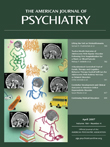Suicide Attempt Following Initiation of Topiramate
To the Editor: Topiramate is approved for monotherapy in partial seizures, generalized tonic clonic seizures, and migraine prophylaxis (1) . Topiramate has been reported to increase suicidality in patients with psychiatric illness (2) . To our knowledge, there are no published reports of suicidal ideation or suicide attempts in patients without preexisting psychiatric illness. We present a case report of a patient without preexisting mental illness who ingested ethylene glycol while receiving topiramate.
A 72-year-old male without past or family history of mental illness, impulsivity, or suicidality ingested a lethal amount of ethylene glycol (175 ml [lethal dose: 1.4 ml/kg to 1.6 ml/kg]) in a suicide attempt after an argument with his wife. The patient believed that this amount of antifreeze would kill him and tried repeatedly to stop his wife from dialing 911. At his psychiatric evaluation 6 hours later, he denied suicidal ideation, was happy to be alive, and regretted his behavior.
The patient denied symptoms consistent with an affective, anxiety, substance-use, dissociative, or psychotic disorder. He recalled the events surrounding his suicide attempt; however, he could not explain why an ordinary argument would provoke such an extreme response. He and his family acknowledged this as uncharacteristic behavior.
Eight days prior to his admission, he began topiramate 25 mg daily for a benign intention tremor, which was increased to 50 mg one day before his suicide attempt. His medical conditions, hypertension, coronary artery disease, and hyperlipidemia were stable and treated appropriately. There were no significant drug interactions.
Topiramate was discontinued. The patient was treated with fomepizole and dialysis. At the 4-week follow-up, he continued to deny affective, anxiety, substance-use, dissociative, or psychotic symptoms, including suicidal ideation.
The mechanism of action in topiramate remains elusive (3) ; however, it is known to diminish functioning of the frontal lobes (4) . In rats and humans, topiramate causes significant disruption in working memory, a process that relies on the frontal cortex (5 – 7) . Since the frontal cortex functions as an important inhibitor of impulsivity, one could hypothesize that our patient’s suicide attempt was a result of topiramate-induced decrease in frontal lobe activity. Further investigation is warranted on the effect of topiramate on impulsivity, since impulsive behavior is a significant risk factor for self-harm. In addition, it is imperative that clinicians continue to monitor and report adverse events to the Food and Drug Administration.
1. Ortho-McNeil: Topamax Prescribing Information, 2005Google Scholar
2. Abraham G: Topiramate-induced suicidality. Can J Psychiatry 2003; 48:127–128Google Scholar
3. Simeone TA, Wilcox KS, White HS: Subunit selectivity of topiramate modulation of heteromeric GABA(A) receptors. Neuropharmacology 2006; 50:845–857Google Scholar
4. Kockelmann E, Elger CE, Helmstaedter C: Significant improvement in frontal lobe associated neuropsychological functions after withdrawal of topiramate in epilepsy patients. Epilepsy Res 2003; 54:171–178Google Scholar
5. Shannon HE, Love PL: Effects of antiepileptic drugs on working memory as assessed by spatial alternation performance in rats. Epilepsy Behav 2004; 5:857–865Google Scholar
6. Smith ME, Gevins A, McEvoy LK, Meador KJ, Ray PG, Gilliam F: Distinct cognitive neurophysiologic profiles for lamotrigine and topiramate. Epilepsia 2006; 47:695–703Google Scholar
7. Mohr HM, Goebel R, Linden DE: Content- and task-specific dissociations of frontal activity during maintenance and manipulation in visual working memory. J Neurosci 2006; 26:4465–4471Google Scholar



